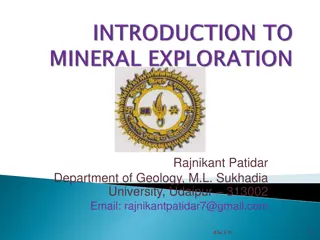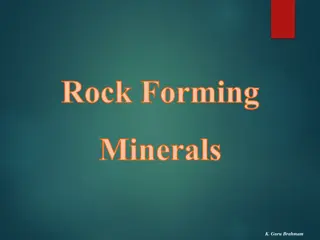Overview of Feldspar Group in Geology: Types, Composition, and Properties
The Feldspar Group is a vital component of rock-forming silicates found in various types of rocks. Comprising two main types - Alkali Feldspar and Plagioclase Feldspar, they exhibit distinct chemical compositions and physical properties. These alumino-silicates are characterized by their atomic structure, optical properties, and varieties like Sanidine, Adularia, Moonstone, Aventurine, and Amazonstone. Understanding their features is crucial for geology enthusiasts and students alike.
Download Presentation

Please find below an Image/Link to download the presentation.
The content on the website is provided AS IS for your information and personal use only. It may not be sold, licensed, or shared on other websites without obtaining consent from the author.If you encounter any issues during the download, it is possible that the publisher has removed the file from their server.
You are allowed to download the files provided on this website for personal or commercial use, subject to the condition that they are used lawfully. All files are the property of their respective owners.
The content on the website is provided AS IS for your information and personal use only. It may not be sold, licensed, or shared on other websites without obtaining consent from the author.
E N D
Presentation Transcript
Feldspar, Feldspathoid and Quartz group Dr. A.V.Tejankar Professor & Head Dept. of Geology Deogiri College, Aurangabad
Introduction This is the most important group of rock forming silicates which occur in igneous, sedimentary and metamorphic rocks. They constitute about 2/3rd of the igneous rocks.
Atomic structure The feldspars are tectosilicates with a structure of a framework silicate of (Si, Al) O4 are linked to one another by sharing oxygen ions in all directions. The resultant framework of tetrahedra has large interstices,occupied by the pottasium ions in the alkali feldspars.
Types Feldspars are of two types : 1) Alkali feldspar(microcline,orthoclase and sanidine) 2)Plagioclasefeldspar(albite,oligoclase,ande sine,labradorite,bytownite and anorthite)
Chemical composition They are alumino silicates of potassium, sodium, calcium and barium, and may be regarded as isomorphous mixtures of the four end member given below, of which the first 3 are common while the fourth is rare. 1)Orthoclase and microcline. (KAlSi3O8) 2)Albite. (NaAlSi3O8) 3)Anorthite (CaAl2Si2O6) 4)Celsian (BaAl2Si2O6)
Physical properties 1)Colour-White,grey or flesh 2)Form-Tabular 3)Lustre-Vitreous 4)Streak-White 5)Cleavage-2 sets, but one is better developed. 6)Fracture-Even to uneven 7)Hardness-6 8)specific Gravity-2.57 to 2.7
Optical properties In Plane Polarised light 1)Colour-Colourless, turbid 2)Form-irregular 3)Relief-Low to moderate 4)Cleavage-Absent In Crossed Nicols 1)Anisotropism-Anisotropic mineral 2)Twinning-Plagioclase feldspar typically shows lamellar twinning 3)Interference colour-The feldspars show grey or white interference colours of low order.
Varieties 1)Sanidine-A high temperature pottasium feldspar 2)Adularia-Low temperature orthoclase 3)Moon stone-Opalescent adularia or albite 4)Aventurine-Gem variety of albite 5)Amazon stone-Bright green microcline
Occurrence 1)Plagioclase are abundant in all types of igneous rocks except the ultrabasic rocks. 2)In basic and intermediate lavas, plagioclase phenocrysts, as well as small grains in the ground mass are abundant and exhibit zoning. 3)Alkali feldspars are restricted to alkali and acid igneous such as syenites, granites, metamorphic gneisses and less frequently in sedimentary rocks like arkose.























